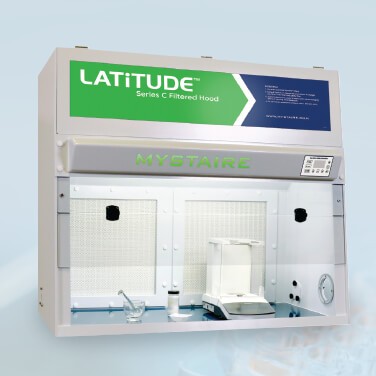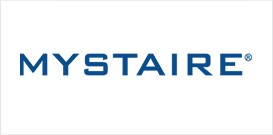Ductless Fume Hood Safety
Protecting People and Processes
Ductless fume hoods are self-contained enclosures that filter air before returning it to the work environment. Typically used in locations where outside ventilation is not an option, these systems feature activated carbon and/or HEPA filters instead of being connected to an external exhaust. In addition to removing hazardous fumes, vapors, and particles from the air, ductless fume hoods offer convenience, mobility, energy and cost savings, and flexibility for facility planning while promoting a greener laboratory.
Protecting Operators
Ductless fume hoods protect the individuals who use them and people working in the same area from fumes, vapors, and particles that can result in injuries and possibly even death. If the intake airflow is not within a specified range, hazardous materials may flow out of the fume hood and cause harm.
The effectiveness of ductless fume hoods also depends on filters that can remove the hazardous materials in question. Users must be able to monitor both the airflow and filter conditions and respond quickly to adverse conditions. Work with the manufacturer to find the right hood for your specific needs.
Protecting Processes
Ductless laminar flow hoods can help protect precious samples and other materials. Optimal airflow prevents samples and materials from being contaminated by a user or substances present in the work environment. Avoid the risk of background or cross-contamination by using appropriate filtration and monitor to ensure that conditions in the hood remain safe for samples and experiments.
When selecting a ductless fume hood, consider the materials that will be handled. With this information, the manufacturer can recommend proper filtration, optimal construction materials, an appropriate filter monitoring package, and the correct size — all of which leads to a fume hood designed to meet your functional and safety needs.
Safety Features
- Blower capabilities
Blowers must maintain face velocity (measured at the fume hood opening as air moves into the hood) at the optimum level for fume containment. - Vapor-proof illumination
Vapor-proof illuminators provide adequate lighting while helping to meet safety requirements for applications involving flammable dust or vapors. - Work area access
The opening should be large enough for you to have free and easy access to the work surface for safely setting up and running experiments. - Integral spill base
An integral spill base can effectively contain any accidental spills that may occur during use. - Monitor for carbon filter bed saturation
Per American National Standards Institute (ANSI) Z9.5 regulations for laboratory ventilation, carbon filters must be regularly monitored for saturation. - Reliable airflow measurement
The 29 CFR 1910.1450 Occupational Safety and Health Administration (OSHA) standard states that fume hoods must maintain an airflow capable of drawing air from the laboratory and preventing or minimizing the escape of air contaminants into the laboratory. - Appropriate materials for preventing hood deterioration
The interior of the hood must resist attack from any chemical fumes and tolerate the full range of temperatures to which it will be exposed. - Rear baffles
The baffles are moveable partitions that create slotted openings along the back of the fume hood to help maintain even airflow.
Safety Tips
Selecting the appropriate safety features for your ductless fume hood is key, but employees must also be trained in its correct use. OSHA offers the following safety tips for working safely with a fume hood:
- Make sure employees understand fume hood operation and are trained in its proper use
- Refer to the product safety data sheet (SDS) if you are unsure about the hazards and risks for any of the products with which you are working
- Turn the fume hood on and confirm that the airflow is within the required range
- Do not place your head inside the hood opening
- Always wear appropriate eye protection
- Check to see that nothing blocks airflow through the baffles or the baffle exhaust
- Elevate large equipment at least two inches above the base of the hood
- Keep materials inside the hood at least six inches away from the sash opening
- Keep the sash closed when the hood is not in use
- Do not store chemicals inside the hood
While conventional hoods are still the most common choice for ventilation, ductless hoods are gaining popularity thanks to their low installation cost, energy savings, design flexibility, and convenience.
But safety comes first, so consider the options and benefits of ductless fume hoods when purchasing a system. The features of a ductless hood combined with properly trained staff will equip you to protect your people and processes from injury or contamination.

Content provided by:
Related Products
Read More from Lab Reporter Issue 2, 2019
- Adaptive Fabric Responds to Changes in Body Temperature
- Brain Metabolism Study Reveals Age Differences Between Sexes
- Chemical Accelerators: The Glove-Related Allergen of the 21st Century
- Ductless Fume Hood Safety
- How to Choose the Right Desiccator
- How to Guard Against Cleanroom Contamination
- Microplastics: Investigating Risk and Understanding Evidence
- Protecting n-Butyllithium from Air and Moisture
- Reduce Strain with Ergonomically Certified Gloves
- Safety Compliance: A Team Effort at Texas A&M
- Save Incubator Space with Round Multilayer Devices
- Second HIV Patient in Remission After Stem Cell Transplant
- Solvent Exposure Can Lead to Hearing Loss
- TCI: Innovating to Improve Lab Safety


